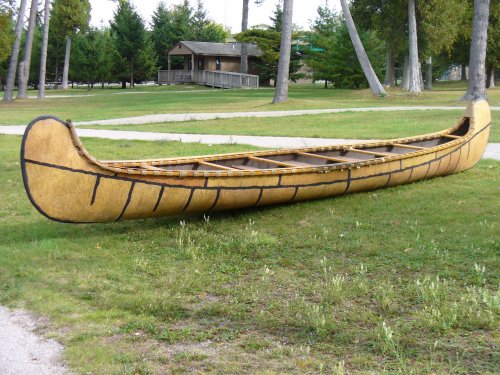

Wow! Grandfather just gave Chogan some much needed hope. Perhaps Chogan and Kanti won't finish last in the canoe race after all. We'll soon find out. It should now be obvious to all you Chogan fans that not all canoes are created equal. Some canoes are short and sleek, while others are big and strong and capable of transporting many people or supplies. Each canoe has its purpose. Chogan is hoping the purpose of his canoe is to win canoe races.
You may have noticed Chogan does not like to walk—not when he can ride in a canoe. The canoe was Chogan’s equivalent to your bicycle or a teenager’s first car; it carried him to faraway places where exciting new adventures awaited him. But Chogan wasn’t the only one who valued canoes. Canoes made life easier for everyone. Native Americans didn’t have wheeled carts or pack animals to pull them. Without canoes, everything had to be transported by backpack. Fortunately, Upper Michigan provided countless lakes with interconnecting rivers for their canoes.
The Short Canoe
In the picture on the left, is hand-crafted birch bark canoe. At twelve feet in length, this canoe will be a “sports car” version of the canoe and capable of fast turns, a necessity for maneuvering in small streams and rivers. (It is similar to the canoe Chogan and Kanti will race.) The birch bark is turned inside out, so the smooth inner layer faces the water. This reduces the resistance and creates a faster canoe.
The canoe is bound together with cedar roots just like the canoe Chogan's grandfather made. During the final phase of construction, the seams will be sealed with pine or spruce pitch mixed with a bit of charcoal for color. Since even the best built canoes frequently leak, it was customary to carry extra pitch and birch bark for quick repairs. Unlike modern canoes, Native American canoes had no seats. The occupants paddled their canoes from a kneeling position. This was hard on the knees, so Chogan and Kanti always carried kneeling pads with them.
The Long Canoe

During winter, food and game were scarce, and many Indian families left their villages to “winter” at remote locations where there was less food competition. The twelve-foot canoe above was too small for transporting an entire family and their possessions to a new location. They needed a much larger canoe such as the canoe at the right. Some of these heavy-duty canoes were over thirty-five feet in length and four and a half feet wide. It was not unusual for these canoes to carry eight to ten adults plus baggage.
Enough about canoes. Let's get back to Chogan and Kanti to see how well they do in the great race. Chogan still fears coming in last.